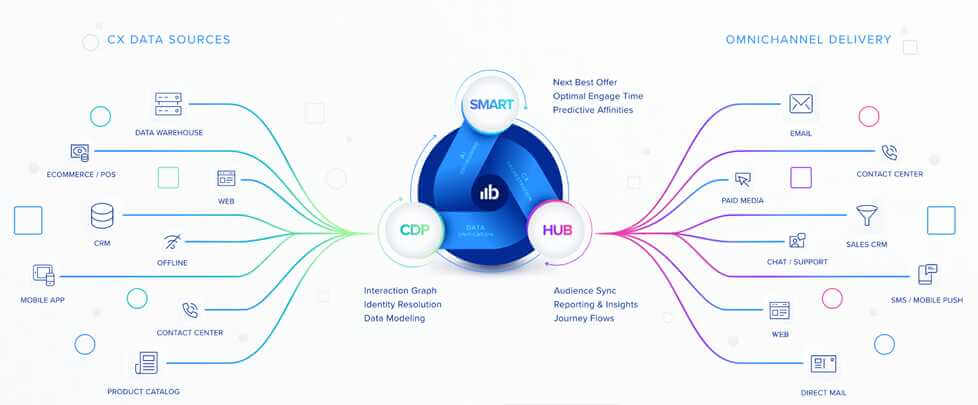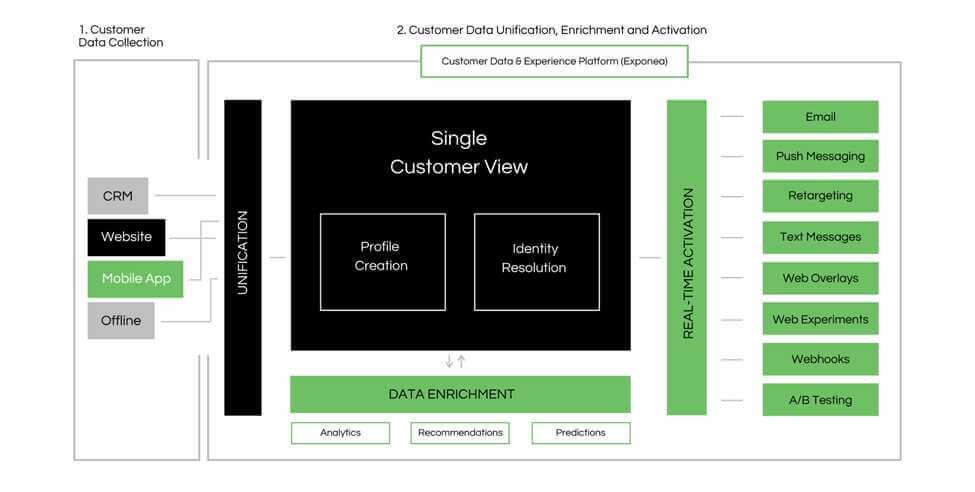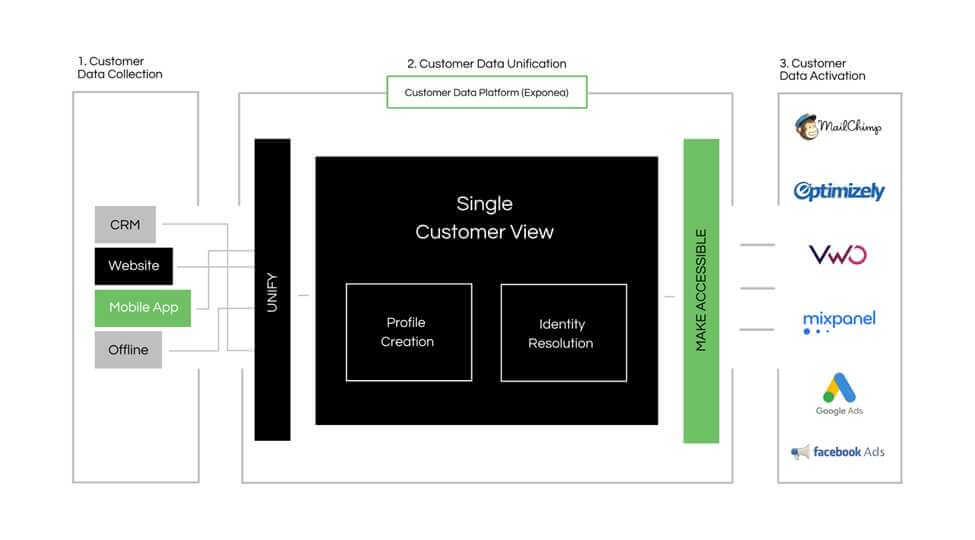
What is a Customer Data Platform?
We know we don’t need to tell you twice that customers are becoming more demanding—especially around digital experience expectations.
Customers expect brands to message them with relevant content when they’re ready to purchase and to surprise and delight them in the right way, at the right time (hello, birthday discounts!).
In order to make all of this magic happen, you first need to store, track, and analyze customer data. A customer data platform (CDP) allows you to do just that—and more.
In this article, we’ll walk you through everything you need to know about CDPs.
Table of contents
- The key CDP elements and a breakdown of CDP types
- How a customer data platform gives you insights to improve the digital customer experience
- How to leverage the 4 primary types of customer data to improve the customer journey
- How to Integrate a CDP with your marketing technology (martech) stack to supercharge data collection, analysis, and activation
- Key takeaways
The key CDP elements and a breakdown of CDP types
All CDPs are built to accomplish the same goal—to provide you with a comprehensive window into customer behavior and insights by way of centralizing your data.
Why does centralizing customer data and business intelligence matter? Because it’s the only way to:
- Gain a holistic understanding of the customer journey;
- Understand what is driving customer intent;
- Learn where you’re satisfying customer needs (so you can double down on what’s working), and;
- Realize where you’re falling short (so you can plug support gaps immediately).
But don’t just take our word for it. McKinsey notes that “predictive customer insight is the future”—and we couldn’t agree more.
CDPs allow you to easily (and securely) store your collective data across channels, mediums, and touchpoints (as represented on the left side of the below image).
Then, leverage those insights (with the help of AI) to make meaningful changes to your customer experience, marketing campaigns, and sales efforts (as represented on the right side of the image):

In essence, you’re pulling in dispersed data (while following data privacy regulations like GDPR), storing it safely, analyzing it, and then pushing those insights back into your ecosystem to enhance the customer experience.
But these platforms aren’t all carbon copies of one another, and that’s intentional.
To paraphrase Smart Panda Labs’ Managing Director Shamir Duverseeau in this Blueshift webinar, buying a CDP is like buying a car. Just like all cars are built to get you safely from point A to point B, all CDPs fundamentally do the same thing.
But, just as you will need different features in a car if you have four kids or live in the snow, for example, you need to get specific about which CDP features and functions suit your unique organization’s needs and experience use cases.
And so you don’t get distracted by fancy features or a compelling sales team, it’s better to ask difficult questions and come up with your list of non-negotiables before you begin assessing CDPs.
Let’s walk through some CDP types and characteristics so you can begin to get a picture of what might best fit your needs.
Types of CDPs
There are four different types of CDPs you’ll likely assess and choose from, based on your organizational needs and what you hope to accomplish.
- CDP Engines: Also known as a CDP toolkit, CDP engines are open source. This makes them well-suited for technical teams looking to customize or add applications on top of an existing CDP.
- Marketing Data Integration: Less action-oriented than some of its counterparts, marketing data integration is focused on governance for data streams. They have limited ability to create and push segments, and analytics are handled outside of the platform.
- SmartHub: This type of CDP excels at marketing workflow and also offers predictive capabilities. They generally focus on known customers as opposed to anonymized personas.
- Marketing Cloud: Less scalable and more customizable and IT-dependent (think: API-reliant) than some of its competitors, marketing clouds can be a solid option for businesses with existing CDP infrastructure and advanced marketing requirements (i.e. out of the box won’t quite work).
Key CDP elements
Here are some of the key characteristics you can expect to find when assessing CDP solutions.
- Ready-to-use: Customer data is organized and available for immediate use (as in, you’re not building anything and a low level of technical skill is required to get up and running).
- Retains data for a long period of time: Some CDPs are known for their ability to store data for a long time. Not all data needs to be retained forever. But if it’s important to your business, make sure your CDP either stores it or pushes it to a data warehouse (or similar repository).
- Real-time capability: The platform updates in real-time, so you can react to changes quickly.
- Open platform: Third-party systems can connect to your CDP to allow for things like delivering targeted, relevant ads.
- Cross-channel personalization: The CDP allows for the personalization of messages across various customer touchpoints.
- Identity resolution: The CDP is able to recognize customers across devices as well as connect the behavior of anonymous visitors with known customers.
How a customer data platform gives you insights to improve the digital customer experience
Now that you know what to look for in a CDP, let’s dive into the benefits and how the insights they provide will help your marketing team improve the digital customer experience.
Centralized data enhances customer journey tracking
Because it’s connected in one central place, both online and offline data pulled from multiple sources, platforms, channels, and/or databases become more accessible and easier to monitor and use.
This 360-degree view into your customer data types allows for more transparency into how marketing decisions are playing out. Subsequently, it allows you to pivot faster if a strategy isn’t working.
This visibility also helps eliminate data silos within your team and cross-departmentally, boosting productivity and simplifying collaboration.
The more ease with which your team members and stakeholders can get—and stay—on the same page, the more nimble and efficient your team will be, which will only positively impact the customer experience.
Additionally, CDP data is largely first-party, which is considered to be the most accurate type of data. With accurate and trustworthy data that everyone can see and understand, you can build a more personalized experience for your customers.
This level of personalization and efficiency helps to build loyalty, improve retention, and ultimately empower more meaningful relationships, not to mention a higher customer lifetime value.
The democratization of data empowers smarter decision-making
In order for data to have an impact, it needs to be trusted. As we mentioned above, when everyone has visibility into the data, your team can make faster, more strategic decisions.
It’s also important that your CDP is accessible—as in, your employees understand and trust what they’re seeing so they feel confident in their decision-making.
Competent data analysis is a critical component of understanding the customer journey and subsequently improving it. A CDP helps you prioritize data management and collection, which in turn helps you prioritize the digital customer experience. The two are intrinsically linked.
Allows for a more seamless operation
Centralizing data removes so many roadblocks between collecting data and implementing it in a thoughtful and strategic way. The right CDP will reduce time-consuming implementations, integrations, and management of multiple digital marketing tools across various platforms.
It will also save your team valuable time which they can then put into analyzing the customer journey, providing a better experience in real-time, and optimizing touchpoints.
What’s the difference between a CDP and a CRM?
We’ll go ahead and assume that you know what a customer relationship management tool (CRM) is, but you may wonder how the data collected differs between a CRM and a CDP.
If you’ve used Salesforce, for example, you understand how data is collected within a CRM. Customer data is captured (usually by automation) as interactions happen across various touchpoints. That data is then stored centrally so your team avoids tool switching and gets a more holistic view of how customers engage with your business.
CRMs are a great way to collect data from customers’ purposeful interactions, such as emails and chat conversations with your customer support reps. You can usually check to see which emails they’ve opened and create a contact history for context that’s accessible across your organization.
With a CDP, data points are gathered from across a variety of channels, sometimes including second and third-party channels, which help to create a unified customer profile. CDPs not only track this data but can also analyze customer behavior and journeys. Uniquely, CDPs help make the data immediately available for activation.
That’s not to say there isn’t a time and place for perusing a comprehensive customer contact history. But if you’re looking for actionable insight, CDPs have your back.
What’s the difference between a CDP and a DMP?
Remember how earlier we shared that first-party data is considered to be most accurate, and therefore, trustworthy? While CDPs focus on this type of data, data management platforms (DMPs) are mainly concerned with third-party data.
This type of mostly anonymous data (like data from cookies and IP addresses) helps you better target ads, for example. CDPs look at the customer journey much more holistically and comprehensively.
How to leverage the 4 primary types of customer data to improve the customer journey
CDPs help you store and track various types of customer intelligence data, some of which may be more important than others (based on your marketing initiatives, goals, audience, journeys, industry, and the like.)
Let’s explore the four primary data types in more detail:
Identity data
Remember when we talked about the first pieces of information you’d plug into a CRM like Salesforce? Demographics like name, address, contact information, and job title are all pieces of identity data.
Knowing this identifier information on a basic level allows your business to identify your target customers, and increase segmentation if need be. It is also essential to personalization; for example, adding a customer’s product information to an email greeting or sending a location-based ad or push notification based on where they live or work.
Descriptive data
Going back to the CRM example, we discussed how you might input notes from a call that would help you personalize or tailor a sales pitch to that specific customer—that’s descriptive data The type of descriptive data you collect will largely depend on your business type and priorities.
For example, a fashion retailer will want to remember your clothing brand and style, whereas a real estate agency may keep track of how many children customers have and when they’re entering school.
For the former, knowing clothing brand and style helps with upselling, cross-selling, and targeted ads. For the latter, the number of children influences how many rooms are needed in a house, and school start dates often influence neighborhood choice and proximity (nobody wants to drive 30+ minutes for a drop-off).
Quantitative data
Quantitative data is where pretty much all of the marketing acronyms come in: email CTR and OR, website UVM, social media likes or shares, and any other activities you can measure with numbers.
Quantitative data will help you understand how often and when a customer engages with your brand. This type of data is the easiest to track than qualitative data but doesn’t always give marketers the full picture.
For example, if someone opened the same marketing campaign email 5 times we may think they’re highly engaged or about to buy when in reality they could have been offended or confused by its content. Or, simply passing the information along to an interested friend!
To get to the bottom of quantitative data to ensure it’s providing a true north (or properly understand that it’s not), you need to add qualitative insights into the mix.
Qualitative data
Where quantitative data shows us how many times your customer opened an email, qualitative data is what will help us distinguish between whether they loved or hated it or simply don’t know how to delete emails without opening them first (hey, it happens).
It also includes data that can’t be measured in numbers, like the answer to the (very important) question, “How do you feel about our brand?”
Qualitative data shows you who your customers are on a deeper level by explaining the why behind customer engagement. What motivates them? What do they love? Are they night owls or early birds? What makes them tick?
Both quantitative and qualitative data are important as standalone metrics and insights, but when combined, boost your ability to provide aligned, customer-driven experiences.
How to integrate a CDP with your martech stack to supercharge data collection, analysis, and activation
It’s pretty clear that a CDP can help supercharge your marketing efforts by centralizing your data and providing visibility across teams and channels.
If you’re considering a CDP for your organization, let’s take a look at how you can best approach integrating it with your existing martech stack.
Lead with your goals
As with all digital tools, to provide the best customer experience, you need to outline your desired outcome. For example:
- What made you read this article in the first place?
- What are you hoping to change or accomplish that led you to want to learn more about CDPs?
- What’s not working with your organization’s current view of the customer?
- What’s currently working (or not) when it comes to storing information in your customer database?
Once you know what the tool is for and how it will help you improve your organization’s marketing systems, and subsequently the customer experience, you can start checking out CDP vendors.
Audit the current state of your data
If you need to cleanse data, that can delay implementation. Understand your existing martech stack and the data housed within it, analyze it, and get your house in order.
Also, talk to your team and get their feedback, as they are the subject matter experts (SMEs) in the trenches and are best positioned to answer these questions. Getting their insight and buy-in now will also help them to trust and leverage the CDP once it’s implemented.
Understand your options to make an informed decision
Once it’s go time, you still have some big decisions to make. It’s important to know what functionalities and customer insights you’re looking for, while also considering your existing technology stack, customer touchpoints, and both your marketing strategy and organization-wide goals.
Standalone CDP vs. Customer Data & Experience Platform (CDXP)
The main difference between these two CDP types is that a standalone CDP doesn’t allow you to also execute campaigns from within the platform (i.e. it does not have an ‘experience’ cloud).
That means that a CDXP does offer an experience cloud.
For example, if you deploy a standalone CDP, you can still collate all of your data in one place, but you can’t act on it based on the CDP capabilities. To do that, you’ll need help from your other tool(s), by way of executing campaigns straight from the source or pulling in capabilities with integrations or an API.

With a CDXP, not only can you collate data from multiple tools, but you can action it through the power of your CDXP.

A standalone CDP may be the better option if you already have an established, modern martech stack and you’re looking to fill a gap. But if you’re in the market for a complete overhaul and a tool that can grow with you, we’d typically recommend a CDXP.
Enterprise vs. industry-specific CDPs
While you may immediately think that an industry-specific CDP may be better suited for your unique needs (and it might be!), there are benefits to choosing an industry-agnostic enterprise option.
An enterprise platform will likely already have many existing integrations, making it easier to scale and grow with you. Pricing will likely be higher with an enterprise platform, but with a higher price often comes increased capabilities and flexibility.
If you don’t need all of that, an industry-specific CDP could work. But keep in mind that every time you do have a new need, you’ll likely have to pay for customization. Typical limitations of industry-specific CDPs include less robust product roadmaps, minimal integration capabilities, and a lower ability to scale.
Integrate and deploy your CDP
Now that you’ve thought through which type of CDP is best for your organization, it’s time to get started implementing it.
You’ll likely have a customer success manager who will walk you through implementation, but here’s what you can expect from the process:
- Connect the CDP to your data sources: What data sources exist within your current martech stack? Leverage your team to make sure you have visibility into every last platform that stores any type of customer information, and connect it all to your CDP.
- Set up customer IDs and attributes tracking: Make sure your CDP has the basics and beyond (need be) For example, some CDPs can also store machine-learning-powered predictions based on their attributes.
- Set up events tracking: Enable your CDP to track behavioral data triggered by a user’s actions, like session length on a blog post or the number of times they’ve opened a certain email.
- Integrate with third-party tools: If you are using a standalone CDP, take care with this last step. It may be tedious, but ensuring everything fits together from the start will assure that your data is as comprehensive as possible. If you’re using a CDXP, this step will (mostly) be taken care of automatically.
Track and optimize the customer journey
Now that all the heavy lifting is done, it’s time to put all of your hard work into action (after celebrating, of course).
Make sure your marketing team and stakeholders all have the necessary visibility into your CDP and that you have systems and people in place to monitor analysis and insights. From there, put that information to use and supercharge your digital customer experience.
Key takeaways
A centralized platform that unifies customer data and provides enhanced visibility and insights into customer behavior can help you vastly improve your customer experience.
To make sure your customer data platform works its hardest for you, it’s important to first assess what you want to get out of it. From there, look for the capabilities and type of CDP that will work the best for your organization.
Put your CDP to work and glean the benefits of having a single source of truth when it comes to what matters most to your customers.
READY TO PROVIDE A BETTER POST-CLICK EXPERIENCE?
Get insights and tips to drive more business from less ad spend, more profit from less cost, and more customer value from less churn.